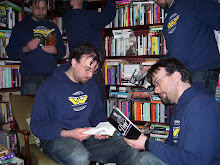There are a lot of drawbacks to being an Australian at the moment: a government whose malevolence and flat-Earthery is matched only by their incompetence (and whose Catholic-heavy leadership recently changed the law in order to make it
easier for refugee children to be sexually abused in concentration camps); an opposition party who has never held a principle that a focus group couldn't break; over-expensive books; a Netflix catalogue only an eighth the size of its overseas equivalents...
But at least we have better-looking Elena Ferrante books than the rest of you.
In the rest of the English-speaking world, the much-acclaimed Ferrante's
Neapolitan Tetralogy, translated and published by Europa Editions (and all power to them, as they have an excellent catalogue of books), look like this:
The only excuse I can think of for these wilfully unappealing covers, the sort you might see on the sort of remaindered commercial fiction which ends its days jumbled up on a low shelf in a post office shop, is that they match the original Italian editions of the books.
But in Australia the books are published by Text Publishing, almost all of whose output is designed by the mighty
W. H. Chong, He has made them look genuinely lovely, with bold monochromatic photographs that might be stills from lost Italian neo-realist cinema masterpieces, and suprisingky subtle gold text. (Click to embiggerificate.)
The presence of the intriguing and beautifully lit female faces on each of these covers is so much more effective than all the turned-away heads on the originals.
Summary: Australia is fucked, but we've got us some pretty books.




























